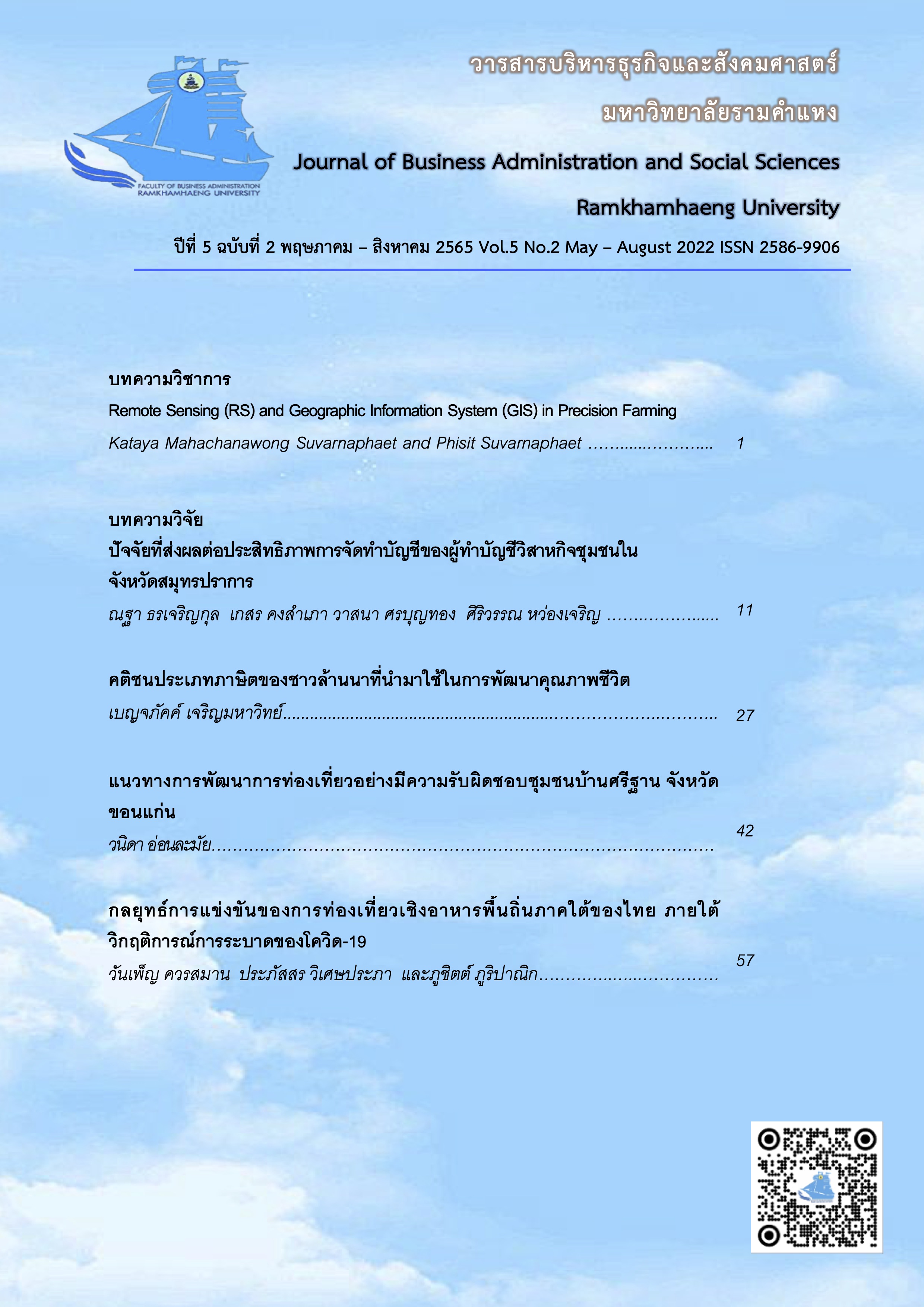การสำรวจระยะไกล (RS) และระบบสารสนเทศทางภูมิศาสตร์ (GIS) ในการทำเกษตรแม่นยำ
Main Article Content
บทคัดย่อ
ด้วยอาหารและเส้นใยทางการเกษตรนั้นคือ 2 สิ่งหลักที่มนุษยชาติมีความต้องการมากที่สุด เกษตรแม่นยำเป็นการปฏิวัติการจัดการทางการเกษตรเพื่อปฏิวัติวิธีการทำงานของเกษตรกร การทำการเกษตรที่มีความแม่นยำสูงด้วยระบบเทคโนโลยีสารสนเทศจะช่วยให้เกษตรกรสามารถรวบรวมข้อมูลและองค์ความรู้ต่าง ๆ เพื่อการตัดสินใจได้ดียิ่งขึ้น นอกจากนี้เกษตรแม่นยำเกี่ยวข้องกับการใช้ข้อมูลทางภูมิศาสตร์เพื่อทำความเข้าใจความแปรปรวนในการทำงานภาคสนามได้ดียิ่งขึ้น ลดการใช้ปัจจัยการผลิต และเพิ่มผลผลิตทางการเกษตร ด้วยพื้นที่ทำการเกษตรที่มีขนาดใหญ่ ประเภทดิน ปริมาณความชื้น ความพร้อมของธาตุอาหาร และตัวแปรอื่น ๆ ที่เปลี่ยนแปลงเน้นเกษตรกรอาจตัดสินใจได้อย่างแม่นยำยิ่งขึ้นว่าปัจจัยการผลิตใดควรจะใส่ที่ใดและในปริมาณเท่าไรโดยใช้การตรวจจับระยะไกล (RS) ระบบสารสนเทศทางภูมิศาสตร์ (GIS) และระบบระบุตำแหน่งทั่วโลก (GPS) ด้วยความรู้นี้เกษตรกรสามารถ ใช้ทรัพยากรที่มีค่าใช้จ่ายสูงเช่นปุ๋ยยาฆ่าแมลงและสารกำจัดวัชพืชรวมถึงการจัดการน้ำได้อย่างมีประสิทธิภาพยิ่งขึ้น
Article Details

This work is licensed under a Creative Commons Attribution-NonCommercial-NoDerivatives 4.0 International License.
เนื้อหาและข้อมูลในบทความที่ลงตีพิมพ์ในวารสารบริหารธุรกิจและสังคมศาสตร์ มหาวิทยาลัยรามคำแหง ถือเป็นข้อคิดเห็นและความรับผิดชอบของผู้เขียนบทความโดยตรง ซึ่งกองบรรณาธิการไม่จำเป็นต้องเห็นด้วย หรือร่วมรับผิดชอบใดๆ
บทความ ข้อมูล เนื้อหา รูปภาพ ฯลฯ ที่ได้รับการตีพิมพ์ในวารสารบริหารธุรกิจและสังคมศาสตร์ มหาวิทยาลัยรามคำแหง ถือเป็นลิขสิทธิ์ของวารสารบริหารธุรกิจและสังคมศาสตร์ มหาวิทยาลัยรามคำแหง หากบุคคลหรือหน่วยงานใดต้องการนำบทความทั้งหมดหรือส่วนหนึ่งส่วนใดไปเผยแพร่ต่อ หรือเพื่อกระทำการใดๆ จะต้องได้รับอนุญาตเป็นลายลักษณ์อักษรจากวารสารบริหารธุรกิจและสังคมศาสตร์ มหาวิทยาลัยรามคำแหง ก่อนเท่านั้น
References
Abhilash Joseph, E., Abdul Hakkim, V. M., & Sajeena, S. (2020). Precision Farming for Sustainable Agriculture. International Journal of agriculture innovations and research, 8(16), 543-553.
Aggarwal, S. (2004). Principles of remote sensing. Satellite remote sensing and GIS applications in agricultural meteorology, 23(2), 23-28.
Alemaw, G., & Agegnehu, G. (2019). Precision Agriculture and the Need to Introduce in Ethiopia. Ethiopian Journal of Agricultural Sciences, 29(3), 139-158.
Andreo, V. (2013). Remote sensing and geographic information systems in precision farming. Instituto de Altos Estudios Espaciales “Mario Gulich”-CONAE/UNC Facultad de Matematica. Astronomia y Física–UNC.
Fu, W. J., Jiang, P. K., Zhou, G. M., & Zhao, K. L. (2014). Using Moran's I and GIS to study the spatial pattern of forest litter carbon density in a subtropical region of southeastern China. Biogeosciences, 11(8), 2401-2409.
Fulton, J., Hawkins, E., Taylor, R., & Franzen, A. (2018). Yield monitoring and mapping. In Shanon, K. D., Clay, D. E., & Kitchen, N. R. (Eds.), Precision Agriculture Basics (pp. 63-78). ASA, CSSA, SSSA.
Georgi, C., Spengler, D., Itzerott, S., & Kleinschmit, B. (2018). Automatic delineation algorithm for site-specific management zones based on satellite remote sensing data. Precision Agriculture, 19(4), 684-707.
Landa, E. R., & Feller, C. (Eds.). (2010). Soil and culture. Springer Science & Business Media.
Lencsés, E., Takács, I., & Takács-György, K. (2014). Farmers’ perception of precision farming technology among Hungarian farmers. Sustainability, 6(12), 8452-8465.
Liaghat, S., & Balasundram, S. K. (2010). A review: The role of remote sensing in precision agriculture. American journal of agricultural and biological sciences, 5(1), 50-55.
Lu, Y. C., Daughtry, C., Hart, G., & Watkins, B. (1997). The current state of precision farming. Food reviews international, 13(2), 141-162.
Maguire, D. J. (1991). An overview and definition of GIS. Geographical information systems: Principles and applications, 1(1), 9-20.
Mendez, D., Labrador, M., & Ramachandran, K. (2013). Data interpolation for participatory sensing systems. Pervasive and Mobile Computing, 9(1), 132-148.
Namgyal, D., Bahar, F. A., Mehdi, S., Saxena, A., Dorjey, S., & Gupta, V. (2021). Remote sensing (RS) and geographical indication system (GIS) techniques in precision agriculture. The Pharma Innovation Journal, 10(8), 1220-1222.
Patil, V. C., Maru, A., Shashidhara, G. B., & Shanwad, U. K. (2002, October). Remote Sensing, Geographical Information System and precision farming in India: opportunities and challenges. In Proceedings of the Third Asian Conference for Information Technology in Agriculture (pp. 26-28).
Patil B, Chetan HT. (2017). Role of remote sensing in precision agriculture, Marumegh, 2(4), 34-37.
Praveen, B., & Sharma, P. (2020). A review: The role of geospatial technology in precision agriculture. Journal of Public Affairs, 20(1), e1968.
Ray, S. S., Panigrahy, S., & Parihar, J. S. (2008). Precision Farming in. Extension of Technologies: From Labs to Farms, 307.
Tayari, E., Jamshid, A. R., & Goodarzi, H. R. (2015). Role of GPS and GIS in precision agriculture. Journal of Scientific Research and Development, 2(3), 157-162.
Wani, M. A. (2019). 15 Remote Sensing and GIS. Agricultural Impacts of Climate Change [Volume 1], 263.
